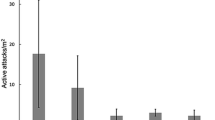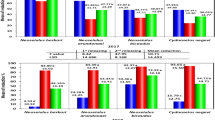Abstract
As part of a continuing effort to eliminate or, at least, reduceLantana camara L., a weed commonly found in Guam, biweekly surveys were conducted over a four and a halfyear period to determine the effectiveness of the weed’s natural enemies in reducing plant vigor and viable seed numbers. A total of eight biocontrol agents were monitored. The leaf damaging insects were the hispine beetle,Uroplata girardi Pic. (Col.: Chrysomelidae), the tingid bug,Teleonemia scrupulosa Stål (Hem.: Tingidae), the leafminer fly,Calycomyza lantanae Frick (Dip.: Agromyzidae) and the noctuid moth,Hypena strigata (F.) (Lep: Noctuidae). The moths,Lantanophaga pusillidactyla (Walker) (Lep.: Pterophoridae),Epinotia lantana (Busck) (Lep.: Tortricidae) andAdoxopheyes melia Clarke (Lep.: Tortricidae) andT. scrupulosa were the flower damaging insects.E. lantana and the seedfly,Ophiomyia lantanae (Froggatt) (Dip.: Agromyzidae) accounted for berry losses. An empirical biocontrol model was fitted to the observed data. The model estimated that the eight biocontrol agents prevented the production of or damaged 225.9 berries per square meter per biweekly observation period. Observed production was only 96.1 undamaged berries per square meter per observation period. Thus, the biocontrol agents were reducing potential berry production by 70.1 percent. The biocontrol model was also used to estimate the individual contributions of the eight agents to the overall control ofL. camara on Guam
Résumé
Dans un effort continu pour éradiquer ou au moins, réduire, la présence deLantana camara L., advantice bien répandue à Guam, un suivi bi-mensuel a été effectué, sur une période de 4 ans et demi, pour étudier l’efficacité des ennemis naturels à affaiblir la plante et à diminuer le nombre de graines viables. Au total, huit agents de lutte biologique ont été recensés. Les insectes s’attaquant aux feuilles sont :Uroplata girardi Pic. (Col. : Chrysomelidae),Teleonemia scrupulosa Stäl (Hem. : Tingidae),Calycomyza lantanae Frick (Dip. : Agromyzidae) etHypena strigata (F.) (Lep. : Noctuidae). Les papillons de nuitLantanophaga pusillidactyla (Walker, (Lep. : Pterophoridae),Epinotia lantana (Busck) (Lep. : Tortricidae) etAdoxopheyes melia Clarke (Lep. : Tortricidae) s’attaquent aux fleurs ainsi queT. scrupulosa. E. lantana etOphomyia lantanae (Froggatt) (Dip. : Agromyzidae) font des dégâts aux fruits. Un modèle empirique de lutte biologique a été établi à partir des données observées. Le modèle a mis en évidence que les 8 auxiliaires empêchent la production ou détruisent 225,9 baies par mètre carré sur une période d’observation de deux semaines. Sur cette même période, la production de fruits non abîmés observée au mètre carré n’est que de 96,1. Ainsi, les auxiliaires réduisent la production potentielle de fruits de 70,1 %. Le modèle a aussi permis d’estimer le rôle tenu par chaque auxiliaire dans la lutte biologique globale contreL. camara à Guam
Similar content being viewed by others
References
Cilliers, G. J. - 1987. The evaluation of three insect natural enemies for the biological control of the weedLantana camara L. -J. Entomol. S. Afr., 50, 15–34.
Denton, G. R. W., Muniappan, R. &Marutani, M. - 1991a. The distribution and biological control ofLantana camara in Micronesia -Micronesica Suppl., 3, 71–81.
Denton, G. R. W., Muniappan, R. &Marutani, M. - 1991b. Status and natural enemies of the WeedLantana camara, in Micronesia. -Trop, Pest Manage., 37, 338–344.
Graaff, J. L. - 1987. The seedflyOphiomyia lantanae and other factors responsible for reducing germination inLantana camara forms found in Natal. -S. Afr. J. Bot., 53, 104–107.
Harley, K. L. S. - 1973. Biological control of Central and South American weeds in Australia. -Paper presented at the 2nd International Symposium on Biological Control of Weeds, Rome, 4–10.
Harley, K. L. S., Kerr, J. D. &Kassulke, R. C. - 1979. Effects in S.E. Queensland during 1967-72 of insects introduced to controlLantana camera. -Entomophaga, 24, 65–72.
Holm, L. G., Plucknett, D. L., Pancho, J. V. &Herberger, J. P. - 1977. The World’s Worst Weeds. -Univ. Hawaii Press, Honolulu.
Landers, M. A. - 1994. Meteorological factors associated with drought on Guam. -Guam Water and Energy Resources Institute Tech. Rep. No. 75, 39 p.
Louw, P. G. P. - 1948. Lantadene A, the active principle ofLantana camara L. II. Isolation of Lantadene B and oxygen functions of Lantadene A and B. Onderstepoort. -J. Vet. Sci., 23, 233–238.
Muniappan, R.-1988.Biological control of the weed,Lantana camara in Guam. -J. Pl. Prot. Tropics, 5, 99–101.
Muniappan, R., Lali, T.S. &Afaisen, D. - 1992. Establishment ofCalycomyza lantanae Frick on Guam for control of the weedLantana. -Micronesica, 25, 217–218.
Ooi, P. A. C. - 1987. A fortuitous control ofLantana in Malaysia. -Trop. Pest Manage., 33, 234–235.
Perkins, R. C. &Swezey, O. H. - 1924. The introduction into Hawaii of insects that attackLantana. Hawaiian Sugar Planters’Assoc. -Entomol. Ser. Bull., 16, 1–83.
Perkins, B. D. Jr.-1966. Status and relative importance of Insects introduced to combatLantana. - Ph. D. Dissertation, University of Hawaii, Honolulu. 80 p.
Ramachandra Rao, Y. - 1920.Lantana insects in India. - Memoirs Dept. Agric, Indian Entomol. Serv. 5, 239–314.
Schreiner, I. - 1989. Biological control introductions in the Caroline Islands. -Proc. Hawaii Entomol. Soc.,29, 57–69.
Swarbrick, J. T., Wilson, B. W. & Hannan-Jones, M. A. - 1995. The biology of Australian weeds,Lantana camara L. -Plant Prot. Q. In Press.
Thaman, R. R. - 1974.Lantana camara: Its introduction, dispersal and impact on islands of the tropical Pacific Ocean. -Micronesica, 10, 17–39.
Waterhouse, D. F. &Norris, K. R. - 1987. Biological Control — Pacific Prospects.Inkata Press, Melbourne, 454 p.
Author information
Authors and Affiliations
Rights and permissions
About this article
Cite this article
Muniappan, R., Denton, G.R.W., Brown, J.W. et al. Efficacité des ennemis naturels deLantana camara à Guam : évaluation locale et saisonnière. Entomophaga 41, 167–182 (1996). https://doi.org/10.1007/BF02764244
Received:
Accepted:
Published:
Issue Date:
DOI: https://doi.org/10.1007/BF02764244




